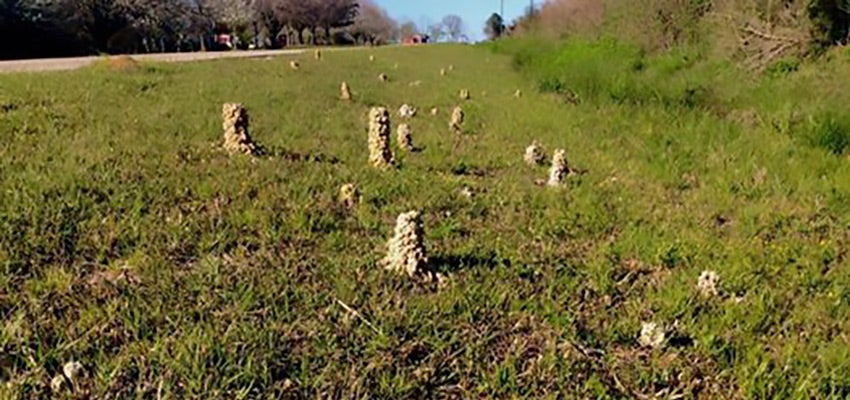Biologists: 10 species of crayfish here
Published 12:14 am Wednesday, March 22, 2017

- These crayfish chimneys were visible near Horn Hill. | Photo courtesy of Mark Bailey
In the recent weeks, those traveling near Horn Hill may have seen fresh burrowing crayfish chimneys.
Local biologist Mark Bailey captured photographs of the beautiful chimneys recently.
Stewart McGregor, director of ecosystems investigations program for Geological Survey of Alabama, said there are currently 10 species of crayfishes – also known as crawfish and crawdads — that have been documented in Covington County, but the number could increase after there are adequate collections from the Conecuh River.
“Most of what we know about the crayfish in Covington County comes from collections in smaller rivers and streams that are easy to sample and the large river habitat has been overlooked,” McGregor said. “Other species may also be found in roadside ditches.”
McGregor said that crayfishes don’t necessarily require a stream or river with permanent surface flow to survive.
“They will burrow underground to the water table to allow themselves to breathe through their gills, much like fish, and not much effort has been put into sampling in that habitat, as you can imagine,” McGregor said. “It is really surprising that as many as four to five species can be found living together in a ditch.”
McGregor said if locals see someone up to their shoulders in a roadside ditch or hauling in traps on the Conecuh River, they are trying to further their knowledge of the distribution and abundance of one of the lesser-known members.
McGregor said that Alabama is blessed with an abundance of aquatic life and is often called the Amazon of North America.
“There are several reasons for that abundance,” he said. “One is the diverse geology of the state, from the low hills of the Highland Rim of North America, south across the flat-topped Cumberland Plateau, to the steep, parallel ridges of the Alabama Valley and Ridge, the ancient, tilted rocks of the Piedmont in east Alabama and on the East Gulf Coastal Plain that covers most of two-thirds of the state. This diversity provides various habitats for animals and plants to occupy based on their preferences.”
McGregor said the state has almost all habitat types in North America except true deserts, alpine mountains and tundra.
“Another reason for that diversity is the antiquity of that diverse geology, which has provided ample time for species to evolve,” he said. “But, perhaps the most important reason for our aquatic diversity is the abundant supply of high quality, sustainable water found in the state. More than 132,000 miles of streams are found in Alabama and perhaps a half billion gallons of water can be found in our underground aquifers.”
McGregor said they are beginning to learn more about the diversity of the crayfish in the state.
“When the Alabama Department of Conservation and Natural Resources realized that we did not have enough knowledge of our crayfish fauna to adequately protect the more vulnerable species, they approached the scientific community to find people and agencies qualified to make those determinations,” he said. “They ultimately contracted Dr. Guenter Schuster, then of Eastern Kentucky University, and Dr. Chris Taylor, of the Illinois Natural History Survey Prairie Research Institute, two of the leading authorities on crayfish in North America, to do some preliminary research.”
McGregor said they have compiled known information about the state’s crayfish fauna from published literature records and unpublished reports and assembled a database from museum and university collections.
That study yielded 82 species from some 5,000 collections.
“So, that was a good record of what crayfish species we had in the past,” McGregor said. “The questions then become: What species do we have now, where are they, and what is the respective conservation status of each species? Are they common? Are they rare? Are they declining in range or number? Are they in danger of becoming extinct? Are they increasing in range and number? Enter the Geological Survey of Alabama, located at the University of Alabama.
“We were hired by the Department of Conservation to make collections of crayfish across the state in each habitat type available,” he said. “As you might imagine, many of the crayfish in museums were found when fish biologists were documenting the incredible fish fauna in wadable streams and happened to collect crayfish and put them in their collections for future study.”
McGregor said that less-well known species are found in swamps, small headwater creeks and springs, and large rivers.
“And we have collected in all of those habitats,” he said. “Since 2008, the Geological Survey of Alabama has been working with Drs. Schuster and Taylor, who identify the specimens we collect and update and maintain the database.”
McGregor said that after the initial three-year sampling effort that the they recorded 85 species and more than 6,000 collections.
“A few years later, we were contracted again to continue documenting fauna and we now have records of 96 species from the state with nearly 8,000 records in the database.”
McGregor said some of the new species added to the database were formally recognized as species previously unknown to science and others were known from other states but had not been collected here.
A poster has been developed with the state’s crayfish species.





